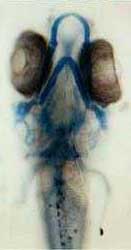About PZ Myers
PZ Myers is a biologist at the University of Minnesota Morris, with a special interest in developmental biology and evolution. He’s been battling creationists and bible-wallopers on the internet since 1993, and has gotten slightly curmudgeonly about it all. The blog Pharyngula is his outlet for venting his fury at faith, stupidity, and injustice, an occupation which somehow led to him being named American Humanist of the Year in 2009, and International Humanist of 2011 by the IHEU. He’s confident that science is the only tool we have for reaching new knowledge, regards faith and ignorance as vices, and finds happiness with his family.
Education
| 1985 | Ph.D. in Biology, Institute of Neuroscience,University of Oregon, Eugene, OR |
| 1979 | B.S. in Zoology, University of Washington, Seattle, WA |
| 1975-1976 | attended DePauw University, Greencastle, IN |
| 1973-1975 | attended Kent-Meridian High School, Kent, WA |
Employment
| 2003- | Associate Professor, Division of Science and Math, University of Minnesota, Morris |
| 2000-2003 | Assistant Professor, Division of Science and Math, University of Minnesota, Morris |
| 1993-2000 | Assistant Professor, Department of Biology, Temple University |
| 1991-1993 | Research Assistant Professor in the Department of Biology, University of Utah |
| 1988-1991 | Post-doctoral research associate with Dr. Michael J. Bastiani in the Department of Biology, University of Utah |
| 1985-1988 | VAX system manager and programmer for the Institute of Neuroscience, University of Oregon |
| 1979-1985 | Graduate research with Dr. Charles B. Kimmel at the Institute of Neuroscience, University of Oregon |
What the heck is a pharyngula?

“Pharyngula” is a term coined by William Ballard to describe a particular stage in the development of the vertebrate embryo. At the pharyngula stage, the vertebrate embryo
- is at the phylotypic stage, an evolutionarily conserved period when vertebrate embryos of all species are most similar to one another.
- has assembled at least the rudiments of most of the major organ systems.
- is expressing the well-known series of Hox genes, regulatory genes responsible for patterning the embryo.
- has a repeated series of pharyngeal arches. These are characteristic chordate tissues that form a ‘basket’ of cartilage and associated tissues in the throat; they contribute to jaws and facial structures, ear bones, gill arches, etc.
It’s an interesting and important period of embryonic development, and happens to be the period my students and I spend a lot of time studying.
If you’re wondering how to pronounce it, try “fa-RING-you-la” or “fa-RINJ-you-la.”











